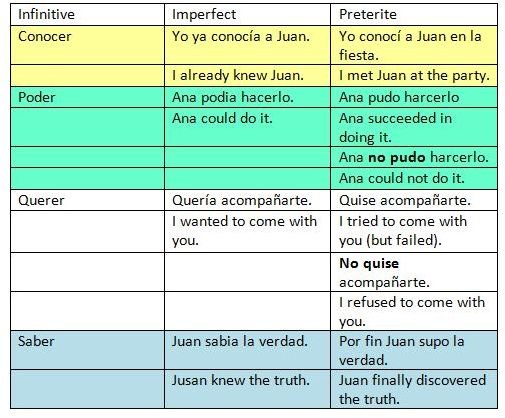When to Use the Preterite vs. the Imperfect: Spanish Grammar
This article is for those who already know how to conjugate in the preterite and imperfect, but might still be confused on when to use which. Also, using the preterite and the imperfect together in the same narrative requires some finesse and judgement.
Using the Preterite
The preterite tense expresses an action that was completed at some time in the past. Specific uses are:
To talk about a series of past actions:
Me levanté, limpié el garaje y me fui al cine. (I got up, cleaned the garage, and went to the movies.)
To talk about the beginning or the end of a past occurrence:
La pelicula empezó a las ocho. (The movie began at 8:00.)
To talk about things viewed as completed:
Compraste el coche hace dos meses. (You bought the car two months ago.)
Using the Imperfect
The imperfect tense expresses an action or state of being that was continuous during the past and its completion is not specified. (The word “imperfect” suggests the idea of “incomplete.”) Specific uses are:
To describe an action that a person did habitually in the past:
Cuando estábamos en Washington, íbamos al cine todos los Domingos. (When we were in Washsington, we used to go to the movies every Sunday.)
To describe an action without reference to any beginning or end:
Juan tenía resfriados constantemente. (Juan constantly had colds.)
To talk about an action that was going on in the past simultaneously with another:
Mi hermano leía y mi padra comía. (My brother was reading and my father was eating.)
To describe physical, emotional and mental states or conditions:
Estaba tan enojado que quería gritar. (I was so angry that I wanted to shout.)
To tell time
Eran las siete y media de la tarde. (It was 7:30 p.m.)
Era la una de la mañana. (It was 1:00 a.m.)
To describe an action or state of being that took place in the past and lasted for a certain length of time prior to another past action. (This is similar to the English use of the past perfect, but in Spanish it is used with the imperfect tense with hacía.)
Hacía cuatro horas que miraba la television cuando mi hermano salió. (I had been watching television for four hours when my brother left.)
Using Both Tenses
Notice in the previous example that the we used the preterite form of salir (salió). This is an example of how we can narrate the past in Spanish. We use the imperfect to say what was going on or what was happening in the background. When the action is interrupted by another action, we use the preterite. Note the switching of tenses in the following narrative:
Mientras estudiaba mi hermano entró. Miré mi reloj. Eran las 8:30. Bajamos las escaleras, y me di cuenta que hacía un poco de frío. (While I was studying, my brother entered. I looked at my watch. It was 8:30. We went down the stairs, and I noticed that it was a little cold.)
Special Preterite Meanings

Four Spanish verbs (conocer, poder, querer and saber) have somewhat different meanings when used in the preterite. Also, notice the slightly different meanings when the preterite forms of poder and querer are used in the negative. These verbs are displayed in the chart on the left.
You can also download the sheet.
Read More About It
Read more on this subject at:
